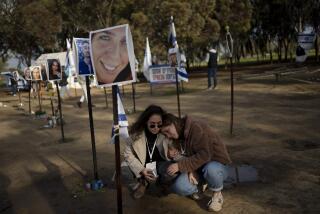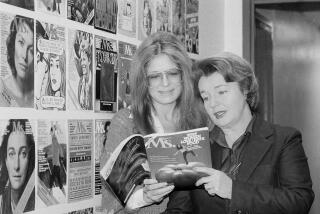BOOK REVIEWS : Feminist Chronicles China and Self
- Share via
I Myself Am a Woman: Selected Writings of Ding Ling, edited by Tani E. Barlow (Beacon Press: $24.95; 364 pages)
Ding Ling led a remarkable life as a Chinese feminist, revolutionary and writer.
In her teens, she participated in the May Fourth Movement, an intellectual, social and political uprising whose pivotal point was the Peking student demonstrations against the Versailles Treaty on May 4, 1919. She spent most of the 1920s in Shanghai, where she became an active writer and anarchist-feminist protester. In the early 1930s, she embraced the Communist cause. Arrested by the Nationalists in 1933, she managed to escape three years later.
Having reached the Communist capital of Yenan in 1937, she soon gained prominence for her political and literary work in support of China’s war against Japan.
Her writing lost some of its subtlety in China’s postwar Communist culture, however, and began toeing the party line (she won the Stalin Prize for Literature for “The Sun Shines over the Sanggan River,” a 1951 novel about land reform). Purged in the anti-rightist campaign of 1957-58, she spent two decades in political exile before returning to Peking, where she lived until her death in 1986.
“I Myself Am a Woman” focuses on Ding Ling the feminist. Preceded by Tani Baker’s fine introduction and ably translated and annotated by a group of Sinologists, it is a collection of her works about individual women and the condition of women in Chinese society.
Ding Ling joined other young writers of the May Fourth Movement to create a new literature in the vernacular language. Rejecting Chinese literary conventions and adapting genres, styles and techniques from the West, these writers opposed Confucian tradition and hoped to transform society by introducing modern values in their works. As the May Fourth writer focusing on women’s condition, Ding Ling portrayed liberated, young, urbane women.
The volume opens with Ding Ling’s most famous early short story, “Miss Sophia’s Diary,” which depicts the complex feelings of a consumptive woman in her early 20s who has fallen in love with a handsome, married man. The work created a national sensation when it was published in 1928 because of its frank description of the sexual desires of a Chinese woman.
A bolder story, “A Man and a Woman” portrays a married woman and a degenerate poet who are drawn together by their lust.
Ding Ling began writing fiction on political themes after joining the League of Left-Wing Writers in 1930. A transitional piece--the novella “Shanghai, Spring 1930”--presents amorous relationships in a class context, depicting conflicts between politically engaged individuals and their ill-suited bourgeois lovers.
Subsequent works uncritically followed the party line, replacing inner conflicts with political conflicts, love with class struggle. Women are portrayed as victims of class oppression in the stories “Web of Law” and “Affair in East Village.” The rape of Chinese women in stories such as “New Faith” epitomizes the evil of enemy soldiers.
Though written after her political conversion, Ding Ling’s novel, “Mother,” treats a historical subject. Based on her mother’s life, it depicts the experiences of a widowed gentry woman who enters one of China’s first academies for women. It is an excellent account of the emancipation of Chinese women through education in the beginning of this century.
In Yenan, Ding Ling asserted her literary independence and exposed problems in Communist society, setting herself at odds with party authorities. Her story “When I was in Xia Village” depicts the injustice perpetrated against a young peasant woman who is ostracized by her fellow villagers after serving as a prostitute and spy behind enemy lines.
The author’s most defiant work, the essay “Thoughts on March 8,” revealed the inequality of women living in Yenan and lambasted leaders for their evasion of problems. As literary editor of the official party newspaper, “Liberation Daily,” Ding Ling published this critical essay and those by other writers in the spring of 1942. This led Mao Tse-tung to convene his Yenan Forum on Literature and Art in which he set down narrow guidelines for writers.
The final story, “Du Wanxiang,” published in 1978 after Ding Ling’s return from political exile, paints a glowing portrait of a female peasant who becomes a model worker. Ding Ling obviously wrote this piece to show her unflagging faith in the Party.
But adherence to the proper political line meant the suppression of her literary independence, creativity and passion. Interestingly, at the time “Du Wanxiang” appeared in print, younger Chinese women writers were just beginning to march down the path Ding Ling had paved 50 years earlier, dauntlessly exploring the emotions, concerns, and problems of women in a society in flux.
More to Read
Sign up for our Book Club newsletter
Get the latest news, events and more from the Los Angeles Times Book Club, and help us get L.A. reading and talking.
You may occasionally receive promotional content from the Los Angeles Times.










